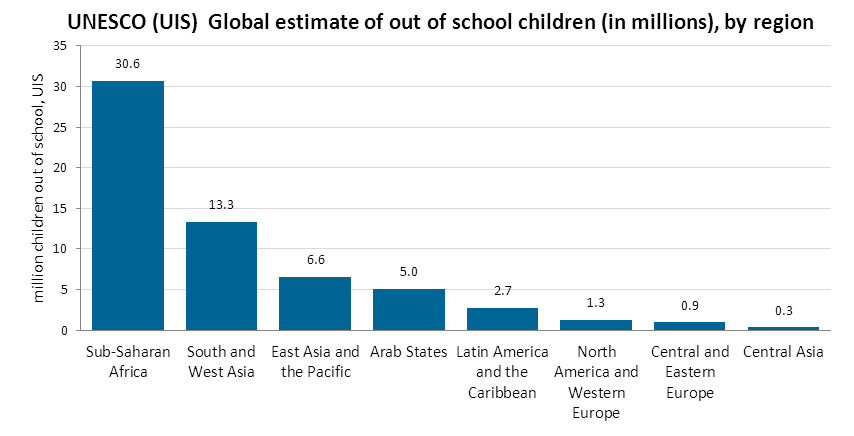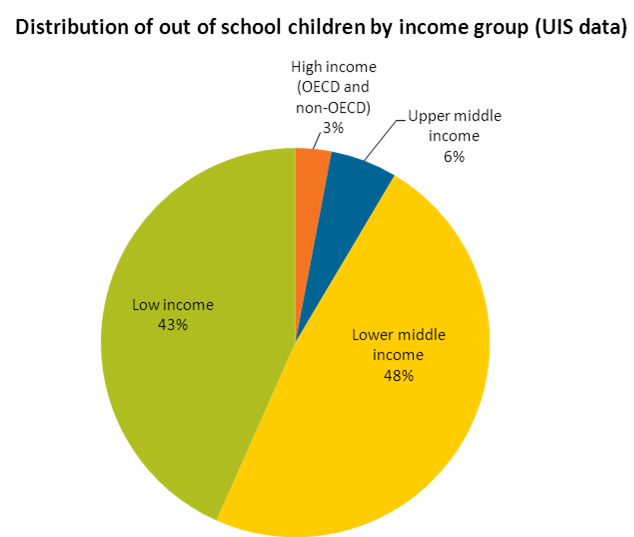You are here
Distribution of Out of School Children
Geographic Distribution

By far, the regions with the largest contribution to the UNESCO global estimate of out of school children are Sub-Saharan Africa and South Asia, with over 70% of the global total. South Asia, with its relatively small geographic territory, accounts for half as many children out of school as Sub-Saharan Africa. These two regions are characterized by both high overall population levels and high rates of non-participation, and are home to the highest single contributors to the global out of school estimates: Nigeria, with its 10 million, and India, with 2.3 million according to UIS (or 21 million, according to household survey data). Only three out of 14 countries with one million or more children out of school are located outside of these two regions. Although countries around the globe, including those in North America and Europe, may at times struggle to provide all of their citizens with stable access to schooling, the geographic breakdown of the global estimate indicates that children’s exclusion from schooling is a problem that disproportionately impacts the global South. As we observe data collected from other sources, this geographic pattern holds regardless of the source of the data.
Income Distribution
 Examining the distribution of out of school children by income groups provides another useful angle for examining the areas of greatest need. For this break down, we use the World Bank’s income group classification, which is based on gross national income per capita[1]. Unsurprisingly, over 90% of the current UIS global count of out of school children comes from low and lower middle income countries. There are clear outliers in each of the income groups. Fifty-four percent of out of school children across the low income group are in just four countries: the Democratic Republic of Congo, Bangladesh, Ethiopia, and Afghanistan, according to the e-Atlas on Out of School Children, which publishes the most complete set of UIS data for the period of 1990-2010 on this indicator[2]. In the lower middle income group, outliers such as Nigeria and Pakistan together account for over half of the number of out of school children, due to a large extent to their sheer size. The same is true for India: even with the low official out of school rate of 2% according to the latest UIS data, the sheer volume of the population in India still makes it a substantive contributor[3]. While the proportion of the global estimate coming from high and middle income states is small, it is notable that national-level figures are over 100,000 in ten countries, and over 1.2 million in the United States.
Examining the distribution of out of school children by income groups provides another useful angle for examining the areas of greatest need. For this break down, we use the World Bank’s income group classification, which is based on gross national income per capita[1]. Unsurprisingly, over 90% of the current UIS global count of out of school children comes from low and lower middle income countries. There are clear outliers in each of the income groups. Fifty-four percent of out of school children across the low income group are in just four countries: the Democratic Republic of Congo, Bangladesh, Ethiopia, and Afghanistan, according to the e-Atlas on Out of School Children, which publishes the most complete set of UIS data for the period of 1990-2010 on this indicator[2]. In the lower middle income group, outliers such as Nigeria and Pakistan together account for over half of the number of out of school children, due to a large extent to their sheer size. The same is true for India: even with the low official out of school rate of 2% according to the latest UIS data, the sheer volume of the population in India still makes it a substantive contributor[3]. While the proportion of the global estimate coming from high and middle income states is small, it is notable that national-level figures are over 100,000 in ten countries, and over 1.2 million in the United States.
[1]World Bank country and lending groups
[2]UIS no longer publishes OOSC rates for Afghanistan; the figures in the Global Initiative e-Atlas are from 1993.
[3] The DHS survey indicates that the non-attendance rate in India was 17% in 2006, even as UIS showed an out of school rate of 5% in the same year, and 2% two years later.

Comments
Poverty levels
Thank you Rodri38. Yes, we
NCLB
Thank you Torsten_Jr. Yes,
Add new comment